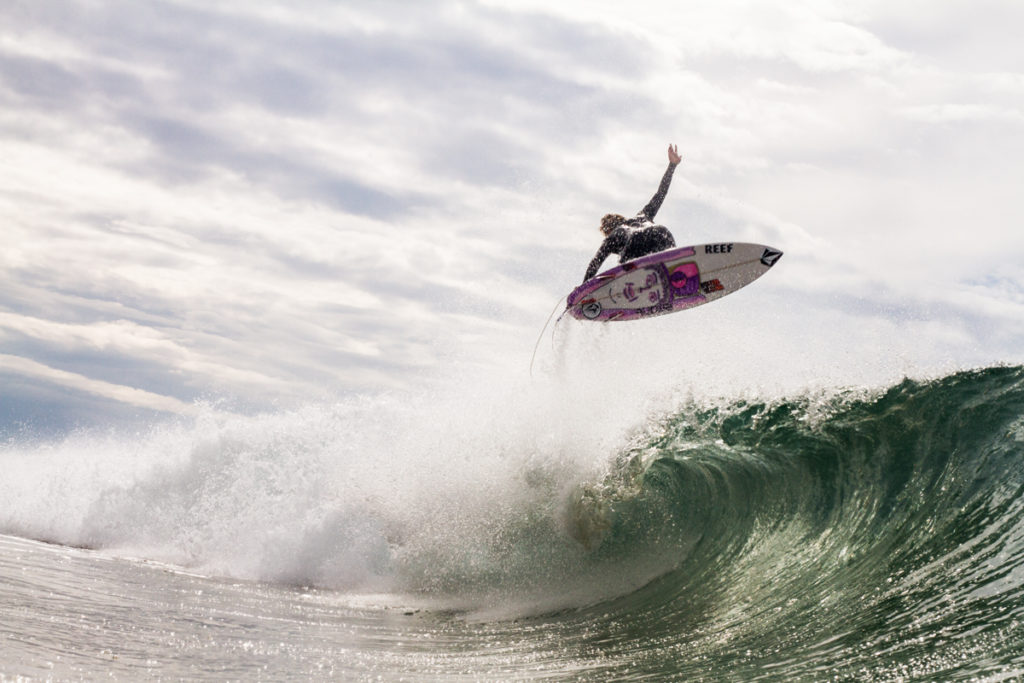Buy Now, Pay Later

Free Surfboard Advice
Customer Service 9am - 5pm (UK)
Trusted by Pyzel

To establish themselves in the male-dominated surfing world, women have faced many challenges over the years. As recently as 30 years ago, the women’s world champion surfer received no prize money and a damaged trophy! The fight for gender equality has been a long, hard road – especially when it comes to big wave surfing.
A new documentary, called Girls Can’t Surf, has interviewed a number of female professional surfers. They describe the gender inequalities and blatant sexism they have experienced. As late as 1989, one top surfing event decided not to have a women’s competition – choosing a bikini contest instead.
Considering women’s surfing dates back to the 15th century, and probably even earlier, it seems shocking that the first women’s big wave surf contest only took place in 1986.
The first documented female surfer was Princess Kelea, of the Hawaiian island of Maui. Known as the Maui surf riding princess, Kelea was said to be the best surfer on the island in 1445. She married a high-ranking chief and moved to his village in the O’ahu uplands. However, she was gripped by “surfing fever” and eventually left her husband to return to her former island home in Maui.
While riding a sweeping south swell at Kalehuawehe, she met her former suitor, Kalamakua. Their love rekindled and they later married and had a daughter, Lāʻieikawai. Their shared love of surfing cemented their union for the rest of their lives.
Fast forward more than 500 years to 1959, when the first documented female big wave surfer was Linda Benson, of California, who rode a 20ft wave at Waimea, Oahu. While women have been surfing alongside men throughout history, sexist attitudes have persisted.
In 1963, big wave surfing pioneer Buzzy Trent (author of an article entitled Big Waves Are Masculine, Women Feminine) stated he “couldn’t stand girls attempting to ride big waves”. The San Diego native gained international fame when he was photographed riding a 20ft wave at Mākaha in 1953.
However, despite women having matched his feat, he apparently had a low opinion of their abilities. When asked how he felt about female surfers, he reportedly said, “It’s certainly better than drinking in taverns or walking the street.”

In 1993, Australian surfer Pauline Menczer, then aged 23, was the women’s world surfing champion. At the time, she recalled the men’s world champion receiving a £25,000 bonus, but she received nothing. When Menczer was handed the trophy on the podium in Honolulu, she found it rattled.
Closer inspection showed it was poor quality and broken, with the metal trophy not fixed properly onto the wooden base. She felt the lack of cash and a damaged trophy summed up the attitude to women’s surfing in the 1980s and 1990s.
Menczer, now 52, had overcome chronic illness and tragedy to become the world’s number one. She had grown up as one of four siblings in a poor neighbourhood of Bondi. When she was five years old, her father, a taxi driver, was murdered in his cab. Her mother brought up the children alone.
She and her brothers would go on the beach in the evening, after the visitors had gone home, looking for clothes and towels they could use, or any junk they could sell at garage sales. She learned to surf on half an old surfing board, after her brother had accidentally broken his.
She recalled there were very few female surfers where she trained and the males were often aggressive towards her. Unpleasant memories of youths pulling her leg rope, so she couldn’t catch the wave, remain with her to this day. She was even deliberately pushed off her board on occasion.
Aged 14, she was diagnosed with rheumatoid arthritis, leaving her in agony by 1993 – the year she became world champion. After learning to live with the pain, she walked carefully down to the water’s edge, but transformed as soon as the hooter went.
With an incredible desire to win, despite her friends sometimes having to push her in a shopping trolley, as the pain was so bad after surfing and she was struggling to walk; she never had a major sponsor and never earned a great deal of money. In 2018, she was finally inducted into the Australian Surfing Hall of Fame.
Menczer’s appearance in the Girls Can’t Surf documentary has brought her into the public eye again as a constant campaigner for women’s surfing. An image of Menczer was added to the surfers’ mural at Bondi beach’s boardwalk by artist Megan Hales in 2022.
The first recognised female big wave surfer, Linda Benson, was only 15 years old in 1959 when she famously rode a 20ft wave at Waimea. Born in May 1944, in Encinitas, California, she started surfing at eleven.
She made her competitive debut by winning the 1959 West Coast Surfing Championship, going on to win the Makaha International contest in Hawaii soon afterwards. She also won the West Coast Championship in 1960 and 1961, the United States Invitational in 1964 and the US Championship in 1964 and 1968.
As the first female surfer to appear on the cover of a surfing magazine in 1963, when she graced the front page of Surf Guide; Linda Rae Benson, who died in 2015, was inducted into the Surfing Hall of Fame in 1992. Talking about surfing the big waves, she said, “I don’t remember fear. I just wanted to do what the guys did.”
After years of inequalities, female surfers were finally awarded equal pay across the sport in 2018. Two years earlier, in September 2016, six women founded the Committee for Equity in Women’s Surfing and lobbied the male-dominated sport to include women in the competitions.
In November 2016, they asked the Coastal Commission not to issue a permit for the famous Mavericks competition, on the California coast, unless 12 female surfers were included, and the prize money was equal for both men and women. In 2018, there were still huge differences – women received as little as 25% of the men’s prize money.
The CEWS threatened the Coastal Commission with legal action on the grounds it was violating civil rights laws in all surfing contests worldwide. The campaign was publicised in the newspapers. In September 2018, the World Surf League announced it would offer equal prize money worldwide for men and women.
In October 2018, the Mavericks’ opening ceremony was held with the inclusion of female surfers for the first time in history – and with equal prize money!
The WSL Championship Tour returned to Tahiti, with the 2022 Outerknown Tahiti Pro, from 11th to 21st August – the first time women competed at Teahupo’o (the surfing venue for the 2024 Paris Olympics) in 16 years. It has been hailed a step further towards women’s equality in surfing.
This year, for the first time ever, the women’s CT competition schedule has mirrored the men’s. They are competing at an equal number of events, at the same locations, throughout 2022.
© 2024 Ocean Magic – The Factory. All rights reserved. Company Number: 04664716. VAT Registered 807 8508 12

Get 10% off your first order!
Join the Lineup!